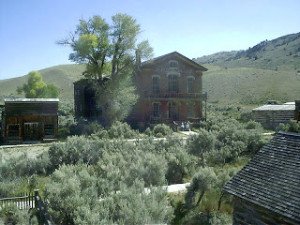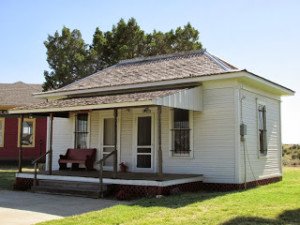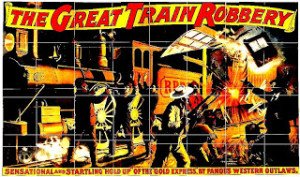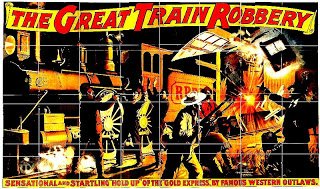Cowboys and Outlaws
To say that literature describes the old west cowboy in different ways is a true understatement. Add television to the mix and the cowboy life is portrayed in an even wider range. Whether the cowboy was written of in the nineteenth or twentieth century makes little difference. There are many story lines attached to the cowboy…some very true and others total fabrication.Was it a romantic life, a hard and dirty job or perhaps something in between.
Thank you for reading this post, don't forget to subscribe!
In many ways the same holds true for the portrayal of outlaws. Literature has portrayed the old west outlaw from a romantic Robin Hood type character to a murderous psychopath.
There are questions to be asked. The questions are…who really was the American cowboy and what was the cowboy life really like? What was the difference between outlaws and cowboys? In some cases maybe no differences. In others, total differences. The biographies of these two type individuals often intersect. While there have been inaccurate portrayals written about both, the largest inaccuracies have probably been written about the cowboys. There was a great deal published about the subject during the latter part of the 1800’s and, in a way, literature often helped shape events. In fact, successful western literature in the latter 1800’s was similar to what sells today on bookshelves. The wild west was wild, but perhaps not as wild as often presented to sell books and movie tickets.

The Dime Novel depicted both outlaws and cowboys as a wild bunch. In Lewis Atherton’s book, The Cattle Kings, the author points out that Mark Twain himself described the cowboy as more gunman than ranch worker.
Roughing It
Twain worked for a time at the Virginia City Enterprise, Nevada Territory’s first newspaper. Twain wrote glamorizing accounts of the western cowboy. Twains experience in Virginia City gave him the background to write a book, Roughing It, in 1872 which was the real start of his literary career. In his book, Mark Twain makes mention of bad men stalking the streets and moving easily from ranch to mining camp. Twain describes them as wearing long coats, cocked hats and revolvers. He goes on to further describe them as brave and reckless fellows who traveled with their life in their hands and who did their killing most within their own circles. They thought it shameful to die with their boots off.
All of this was Mark Twain’s account of the outlaw of the west. While this account stirs interest among readers, it also omits quite a bit of factual information. Nevertheless, this type of literature sold well. Twain was describing the outlaw, not the cowboy.. Although somewhat similar in appearance to the cowboy, the outlaw or bad man was an entirely different individual.

The Big Bonanza
There was a book written by the senior editor of the Virginia City Enterprise, Dan De Quille. The book was encouraged by Mark Twain who urged De Quille to write a factual account of life in the Virginia City mining town. De Quille did publish his book in 1876 titled, The Big Bonanza. De Quille basically agreed with Twain’s account with the exception that he didn’t glamorize the violence. Instead, he denounced it and the men who caused it. It’s not surprising to note that Dan De Quille’s more realistic account didn’t sell as well as did Twain’s book.
According to the book, Cattle Kings, another book, Historic Sketches of the Cattle Trade of the West and Southwest, this one written by a Joseph G. McCoy who is credited with bringing ranchers and cattle buyers together in Abilene Kansas, described the cowboy and his dress in colorful terms.
McCoy wrote that..mounted and drunken, they charged wildly through the streets, shooting up the town as they went, or rode directly through the swinging doors of saloons to demand drinks at pistol point. Literature published by both Mark Twain and Joseph McCoy, attached a code of reckless action by the cowboy in the 1870’s that gave or proposed a style of behavior for new cowboys to emulate. This was a mixing of the cowboy and outlaw culture and I think gives the wrong impression of the cowboy. It has been written however that serious individuals who entered the ranching world in the late 1870’s and 1880’s actually found this much publicized code of conduct either humorous or irritating. Although colorful, it wasn’t necessarily accurate.

What the Ranchers Had to Say About Cowboys
If you really want to find an accurate account of the cowboys of the old west, there is probably no better source than ranchers of the era. First of all, ranchers were not selling books. They were in the business of raising and selling cattle and anything that would disturb that process was unwelcome. Ranchers employed cowboys and at the same time laid down the rules. In fact, ranchers operated in areas far removed from the courts and oftentimes lawmen. The ranchers were in the position to make the laws and enforce them. Some ranchers were small operators and others large corporate concerns. One of the largest, the XIT in the Texas Panhandle, employed about 150 cowboys during it’s peak years.
Was the Cowboy Armed or Unarmed?
Contrary to many of the Hollywood westerns, many ranchers didn’t carry firearms and had rules against their ranch hands carrying guns. Carrying a six shooter was the exception rather than the rule. One of the reasons mentioned for this was the idea that an armed man sent an unspoken message. An armed man would be much more likely to be involved in some sort of violence than an unarmed one. The sometimes controversial “code of the west” prohibited the shooting of an unarmed individual. Most ranch owners simply felt that a sixshooter could only lead to trouble and especially so when mixed with alcohol. This was something detrimental to running a cattle business and was highly discouraged.
The famed Texas rancher, Charles Goodnight, presents a good example of ranching law and order. In the book, Cattle Kings, Goodnight was said to have ordered his cowboys to keep their differences under control while working his long cattle drives. He stipulated that his outfit would hold an immediate trial and hanging of anyone found guilty of committing murder. This reportedly worked effectively for Goodnight. As far as he was concerned, the cowboy could go settle his differences, but not while working on one of his drives. While working on the ranch itself, Goodnight forbade drinking, gambling and swearing.
The above mentioned book also describes how a ranch manager by the name of John Clay handled differences among his employees. Clay was known to settle differences by persuasion. This usually worked. Clay was said to have carried a firearm only once when unruly cowhands ran off one of his supervisors. Again, firearms on the ranch was an exception.
Teddy Roosevelt, when spending time ranching in the Dakota Territory, wrote of his experience and concluded that people had little to fear about murder in the west as long as they minded their business and stayed out of barrooms. Barrooms of the old west being the natural habitat of outlaw and alcohol. Regarding cowboys, Roosevelt pointed out their rough language but contended that it was little different than when any group of all males got together. There was no mention made of shooting up the town.
The Real Bad Men of the West
While the cowboy certainly was spirited, he was also a very hard worker. Many old west cowboys of the late 1800’s were mere teens. Working cattle drives was difficult work and required good physical conditioning. To understand the physical conditioning required to carry out the cowboy’s job, just visit one of the many rodeos held throughout the country and you can see for yourself what was involved.
When cattle drives ended at rail heads such as Abilene, Kansas and later Dodge City ,Kansas, there was a lot of steam to be let off and the cowboys had their pay. You could say it was a time of planned rowdiness. This type of activity was in stark contrast to the western outlaw who would be more apt to target the cowboy.
Again, the ranching industry was involved with the criminal element as well. The western outlaw or gunslinger really came to the forefront after the American Civil War. This was the era of the James Gang, the Daltons, Sam Bass, Butch Cassidy and others. In the case of the James Gang, much of their violence was attributed to lingering hatred from Civil War days, although that is an arguable point. What is significant is that none of the stories about the above mentioned outlaws had a good ending.

The Rustler Outlaw
The biggest bane to the cattle rancher was the rustler. Cattle associations were established to, among other things, deal with rustlers and old west outlaws.
Cattle associations went as far as employing range detectives who many times themselves had prior brushes with the law. Cattle associations themselves were responsible for violence when it came to the rustler, or alleged rustler, such as in the case of the Johnson County War in Wyoming. Rustlers were dealt with severely and quickly and in some cases the ranchers may have hung the wrong person in the rush for justice.
Vigilance Committees
The more you read about the subject of lawlessness in frontier or cattle towns, the more you realize that it was a short lived event. Many old western towns had vigilance committees that dealt with the criminal element their own way. The criminal element the committees were targeting were not drunken cowboys having a good time after trail drives. From vigilance committees came formal law enforcement and often times the two operated simultaneously. It was true that the great majority of murders committed in the old west were between members of the lower element. One reason was that if a rancher or land owner, someone of rank within the community were killed by a gunman, certain retribution was sure to come.
 When one gunman killed another gunman, many in the community were actually glad there was one less outlaw. Stagecoach and train robberies of course did effect law abiding citizens and it took little effort to organize a posse to go in pursuit. In addition to this, if you happened to rob a bank or a train you could be assured to have the Pinkertons on your trail brought in by banking associations.
When one gunman killed another gunman, many in the community were actually glad there was one less outlaw. Stagecoach and train robberies of course did effect law abiding citizens and it took little effort to organize a posse to go in pursuit. In addition to this, if you happened to rob a bank or a train you could be assured to have the Pinkertons on your trail brought in by banking associations.
Outlaws, gunmen, rustlers and others were simply detrimental to business and settlement. The American west was all about business and settlement. It is for this reason that the criminal element was dealt with firmly and swiftly, whether it be by a sheriff, a vigilance committee or the Pinkertons. Sometimes all three working together. To be sure, lawlessness in the frontier town ended more sooner than later.
The dime novels often paint the life of the cowboy and the outlaw with the same broad brush. This is especially true about the carrying and use of firearms. While this portrayal might spice up the mundane, hard working life of the cowboy, there was no similarity between cowboy, outlaw or gunslinger.
The cowboy could be rowdy as Teddy Roosevelt pointed out, but he would be more inclined to be pulling practical jokes and bragging rather than to break the law. Were there bad cowboys? Certainly. Ranchers were quite aware of this. Did some cowboys become outlaws later? Yes. An interesting fact taken from Dodge City Kansas records of 1872 says a lot about the cowboy. It was 1872 that the Atchison Topeka & Santa Fe Railroad reached Dodge City making it an important cattle drive rail head. During that year there were a total of twenty-five murders that occurred during fights. Out of the total of twenty-five only one involved a cowboy.
See additional Trips Into History and Western Trips Articles on the Links Below…
The Saints Roost Western Museum in Clarendon, TX
See the Famous Goodnight Ranch House in Goodnight, Texas
Visit Historic Round Rock, Texas
Museums and Venues to Add to Your Next Trip Itinerary
The National Ranching Heritage Center – Lubbock, TX
National Cowboy & Western Heritage Museum – Oklahoma City, OK
The XIT Museum – Dalhart, TX
King Ranch Museum – Kingsville, TX
Saints Roost Museum – Clarendon, TX
Black American West Museum – Denver, CO
The Rex Allen Museum – Willcox, AZ
Desert Caballeros Western Museum – Wickenburg, AZ
The Western Heritage Museum & Lea County Cowboy Hall of Fame – Hobbs, NM
(Article copyright Trips Into History)

